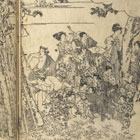Japanese Gallery (Honkan) Room 16
January 2, 2012 (Mon) - February 12, 2012 (Sun)
Japanese people today observe a wide range of events throughout the year. Events from the past survive as customs, such as displaying ornamental dolls for Hinamatsuri, the Girls’ Festival (March 3), or warrior dolls for the Boys’ Festival (May 5); writing wishes on strips of paper for Tanabata, the Star Festival (July 7); and eating sweet dumplings for Otsukimi, moon-watching in autumn, or pumpkin on the winter solstice. Some of today’s annual events began as far back as the Heian period (794 - 1192).
These events were more like repeated ceremonies and were a characteristic of Heian-period politics in which control was maintained by court nobles. As agriculture was central to Japanese life, many ceremonies were related to farming, and subsequently the ceremonies grew to follow a relatively precise schedule with the changing seasons, forming a calendar system. Imperial court ceremonies were also established as annual events to mark the change of seasons. These ceremonies were later adopted by the warrior class, after which they spread to the general population and were absorbed into everyday life.
The pattern of annual events in present-day Japan was formed in the Edo period (1603 - 1868). During this period, the public increasingly became the driving force of society, replacing the court nobles and warrior families who had previously performed this role. At the same time, annual events spread universally across Japan and developed local variations.
This exhibition shows how these events became a part of life for the public. It does this by tracing the historical development of events through objects such as portrayals of imperial ceremonies (the original annual events) and documents depicting events that remain today, as well as by introducing seasonal scenes of Edo (present-day Tokyo) represented in Seasonal Events of Edo and woodblock prints. The exhibition also aims to make visitors consider how “sensitivity to the four seasons” is gradually being lost in Japan.

